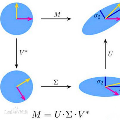Recently, images are considered samples from a high-dimensional distribution, and deep learning has become almost synonymous with image generation. However, is a deep learning network truly necessary for image generation? In this paper, we investigate the possibility of image generation without using a deep learning network, motivated by validating the assumption that images follow a high-dimensional distribution. Since images are assumed to be samples from such a distribution, we utilize the Gaussian Mixture Model (GMM) to describe it. In particular, we employ a recent distribution learning technique named as Monte-Carlo Marginalization to capture the parameters of the GMM based on image samples. Moreover, we also use the Singular Value Decomposition (SVD) for dimensionality reduction to decrease computational complexity. During our evaluation experiment, we first attempt to model the distribution of image samples directly to verify the assumption that images truly follow a distribution. We then use the SVD for dimensionality reduction. The principal components, rather than raw image data, are used for distribution learning. Compared to methods relying on deep learning networks, our approach is more explainable, and its performance is promising. Experiments show that our images have a lower FID value compared to those generated by variational auto-encoders, demonstrating the feasibility of image generation without deep learning networks.
翻译:暂无翻译




